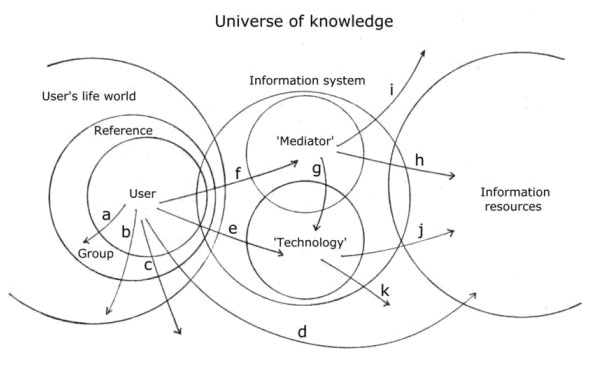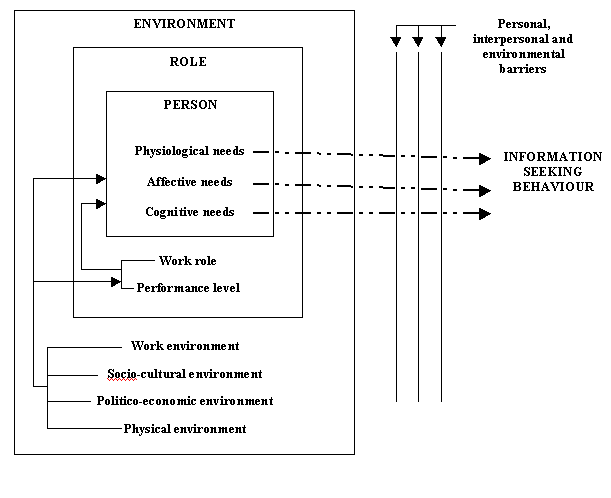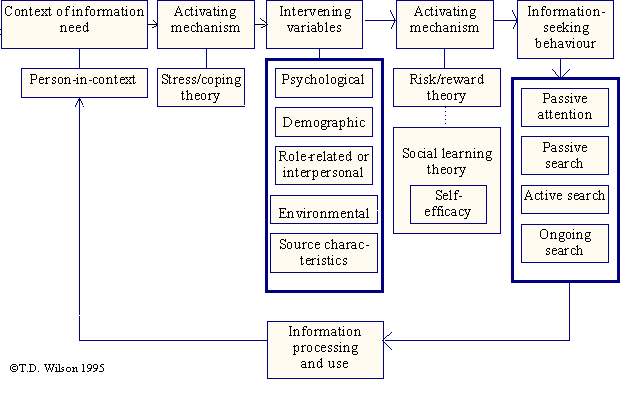Evolution in information behavior modeling: Wilson's model
T.D. Wilson
Professor Emeritus, University of Sheffield, Western Bank, Sheffield S10 2SE, United Kingdom.
Introduction
Wilson's various models of information behaviour (Wilson 1981, 1999b, Wilson & Walsh 1996) were developed over time. The first set of models, published in 1981 had their origins in a doctoral seminar presentation at the University of Maryland in 1971, when an attempt was made to map the processes involved in what was known at the time as 'user needs research'.
That early, unpublished model contained the germ of the most frequently cited model in the 1981 paper, which set out the fundamental categories of causal factors that produce a 'need for information' as well as the barriers that may prevent the person from taking action to seek information. As a result of his work on the INISS Project (Wilson & Streatfield 1980) Wilson presented a series of interrelated models in his 1981 paper, which has become one of the most cited publications in the field.
The key model in that paper, however, was one that is not generally referred to, the second, which is reproduced here as Figure 1. The figure suggests a three-fold view of information seeking: the context of the seeker, the 'system' employed (which might be manual or machine and navigated either personally or by an intermediary), and the information resources that might be drawn upon. All of this is shown to exist within a 'universe of knowledge' that might be drawn upon directly by the information seeker or the intermediary, through, for example, persons as embodiments of knowledge. Note that 'technology' was interpreted widely, in the general sense of anything that aids action: at the time, the application of information technology to information seeking was in its infancy, and neither the personal computer nor the World Wide Web existed. One of the strengths of the model is that, in spite of the changes that have occurred, it continues to serve as a valid framework.

Figure 1: The information user and the universe of knowledge
The most cited model was a development of that used in 1971, which is shown as Figure 2.

Figure 2: Information need and seeking
This diagram models the idea of the personal, social role, and environmental context that may give rise to a need for information. Of particular significance was the division of the 'needs' that give rise to information seeking behaviour into physiological, affective and cognitive needs, and the suggestion that 'information needs' was an unhelpful concept for research purposes. The term 'information seeking behaviour' was proposed because behaviour is observable, whereas 'needs' being internal mental states, are not.
Curiously, the models presented in the 1981 paper, although frequently cited, were not elaborated upon to any significant extent by other researchers. Consequently, when Wilson found himself free once again to take up research into information seeking behaviour, there had been very little progress in developing a general model of information seeking behaviour.
At this point he obtained funding for a study of related research in a range of disciplines, since it had been evident to him that the behaviour of information users had become of increasing interest in areas such as information systems development, health information systems, consumer behaviour and other fields.
Examining this literature he found that the models from 1981 could be used as a framework to integrate studies from this diversity of fields. The result was a development of Figures 1 and 2 above into a new general model of information seeking behaviour, reproduced as Figure 3. In addition to its publication as part of the research report (Wilson & Walsh 1996), the model, together with a review of the related research, was published in the research journals (Wilson 1997, 1999b).

Figure 3: A revised general model of information seeking behaviour
The place of theory
Wilson's model is not derived from any theory proposed by other writers but from an analysis of human information behaviour, partly a priori, but also from the detailed analysis of the information behaviour of social workers and their managers carried out as part of Project INISS. Various influences informed the construction of the model in its original form, particularly general systems theory and phenomenology, but the influences are not overt.
However, the latest version of the model directs attention to theory that might be used to explore various aspects. Thus, the decision to take action to satisfy a need for information is related to stress-coping theory (Folkman 1984), while the decision to search information resources is associated with risk-reward theory (Settle & Alreck 1989) and with the theory of self-efficacy (Bandura 1977). Although not evident in the model, and not explored further in the associated papers, it is also possible to relate various theories of learning to the 'information processing and use' stage of the cycle shown in Figure 3. Probably the most popular approach in this area at present is 'constructivist learning theory' (see, for example, (Steffe & Gale 1995).
Methodological implications
In 1981 Wilson made a plea for the introduction of qualitative methods into research in information science - perhaps the first researcher to do so. However, qualitative methods are not an integral part of the development of the model, nor a necessary consequence of using the model to guide research ideas. The 1981 plea was made in the light of a realization that the prevailing, positivistic model of research had failed to give rise to an understanding of the causes and consequences of human information behaviour because of its orientation towards the use of systems. However, Wilson holds that methods are subservient to purpose and that, having attained understanding through qualitative research, it is necessary to determine the generality of one's findings through quantitative research. Thus, the project on 'Uncertainty in Information Seeking' (Wilson 1999a) was undertaken to test a number of ideas with a much larger selection of information seekers than is usual with qualitative research.
Connections
Wilson's model is a very general model and is not only hospitable to theory that might help to explain the more fundamental aspects of human behaviour, but also to various approaches to information seeking behaviour and information searching. In one iteration of the model, Wilson incorporated Ellis's 'behavioural characteristics' of information seeking (Ellis 1989), which describes the activities of the information seeker engaged in the 'active search' mode of information seeking. Similarly, Erdelez's (1997) 'information encountering' may be seen as an elaboration of the 'passive attention' mode.
Similarly Kuhlthau's (2004) treatment of the information search process is a detailed analysis of the stages in the active search for information, although not, of course, restricted to a single search episode. Dervin's (1996) 'sense-making' theory can also be associated with Wilson's model, in that it deals with the perception of a need for information - the experienced 'gap' in one's knowledge - and the steps taken to 'bridge' the gap.
In other words, the model draws attention to the interrelated nature of theory in this field, whether drawn from other disciplines, or from with the research traditions of information science. The value of a model of this kind lies in drawing the attention of the researcher to the totality of information behaviour and showing how a specific piece of research may contribute to an understanding of the whole. It has no pretensions to explaining everything to do with human information behaviour, but it is hospitable to explanations set out by others and it prompts the researcher to ask the question, "Given my findings, what are the implications for these related areas?"
Wilson has also proposed that information seeking behaviour can be seen as goal-determined and that 'problem solving' provides a framework that can help to explain, for example, multiple search episodes, as the information seeker moves through the problem solving stages of problem recognition, problem identification, problem resolution, and solution statement. This model is also compatible with the 1996 framework, since it deals with the activities engaged in once the person has overcome the barriers to information seeking. These ideas are most fully elaborated in (Wilson, et al. 2002))
Use
By February 2004, the two papers that included the 1996 model had received 109 citations [189 in October, 2007], according to ISI's Web of Knowledge database, six of which were self-citations. The original 1981 paper had 91 citations by the same date [128 in October, 2007], of which only 87 could be identified because of errors in the citation file. Of these eight were self-citations. However, the total number of papers in which the models were cited was smaller (since authors tended to cite more than one of the papers): when the duplicates and self-citations were removed from the file, 124 papers remained.
As for 'Web citation', searches on Google [Note - not Google Scholar] revealed 242 'hits' for the 1981 paper [696 in October 2007], 146 for the IP&M paper [320], and 157 for the 1999 Journal of Documentation paper [800]. As of October 2007, Google Scholar recorded 200 citations of the 1981 paper; 184 for the IP&M paper of 1997; and 239 for the 1999 Journal of Documentation paper.
In interpreting these data, we are, of course, subject to the usual restrictions of citation analysis: unless we undertake a detailed analysis using the original documents, it is impossible to describe the context in which the cited papers have been used. In some cases they may be used to support a line of argument, in others they may be cited only as token recognition of previous work, and in others the arguments in the original paper may be refuted.
However, with these caveats in mind, we can note that the papers have been cited in seven issues of the Annual Review of Information Science and Technology from 1986 to 2003, and in 2001 they were cited in two different chapters in the same issue. Looking at the journals in which they have been cited we find the major refereed journals in the field:
| Journal Title | Citations |
|---|---|
| Journal of Documentation | 17 |
| Library and Information Science Research | 15 |
| Journal of the American Society for Information Science (and Technology) | 13 |
| Information Processing and Management | 10 |
| Proceedings of the ASIS(T) Annual Meeting | 8 |
| Library Quarterly | 7 |
| Library Trends | 6 |
| Journal of Information Science | 4 |
Perhaps of more interest, since it indicates some influence beyond the narrow confines of information science is the fact that the papers have also been cited in:
American Journal of Industrial Medicine
Journal of Broadcasting & Electronic Media
Journal of Communication
Journal of Medical Systems
Journal of the American Medical Informatics Association
Journalism Quarterly
Given that the papers have been cited in journals of recognized quality, it is no surprise that the they have been cited by key authors in the field, including: Belkin, Borgman, Choo, Cole, Dervin, Ellis, Erdelez, Fidel, Ford, Ingwersen, Kuhlthau, Nilan, Pettigrew, Savolainen, Sonnenwald, Spink, Vakkari, and Wersig. It can be inferred, at the very least, that these authors find the work worth drawing to the attention of the readers of their own papers.
Conclusion
It is important to understand that Wilson's General Model has evolved over time and that it is necessary to understand the relationships among the various diagrams he has produced to illustrate his model. Thus, it should be understood that Figure 2 above is an elaboration of the box labelled 'Person-in-context' in Figure 3. Consequently, no one model stands alone and in using the model to guide the development of research ideas, it is necessary to examine and reflect upon all of the diagrams in the 1981 paper as well as the 1996 model.
The importance of doing so can be illustrated by reference to a paper by Niedzwiedzka (2003) which proposes that the introduction of an intermediary in the search process is a modification of Wilson's General Model. However, as noted above, the 1981 paper took the role of the intermediary into account and, of course, the intermediary's 'need' to seek information is determined by his or her social role as intermediary and is therefore covered by Figure 2 above.
Wilson's General Model is less a theory than a theoretical framework: that is, although in its latest manifestation, theory plays a role, the Model is aimed at linking theories to action. It seems likely that the Model will continue to evolve as more and more researchers use it as a basis for thinking about the problems of human information behaviour.
Note: this is a slightly revised and corrected version of the chapter published in Theories of information behavior, edited by K. Fisher, S. Erdelez and L. McKechnie and published by Information Today in 2005
References
- Bandura, A. (1977). Self efficacy: towards a unifying theory of behavioural change. Psychological Review, 84(2), 191-215.
- Dervin, B. (1996). Chaos, order and sense-making: a proposed theory for information design. In R. Jacobson (Ed.), Information design. Cambridge, MA: MIT Press.
- Ellis, D. (1989). A behavioural approach to information retrieval design. Journal of Documentation, 45(3), 171-212.
- Erdelez, S. (1997). Information encountering: a conceptual framework for accidental information discovery. In P. Vakkari, R. Savolainen & B. Dervin (Eds.), Information Seeking in Context: Proceedings of an International Conference on Research in Information Needs, Seeking and Use in Difference Contexts, Tampere, Finland. (pp. 412-421). London: Taylor Graham.
- Folkman, S. (1984). Personal control and stress and coping processes: a theoretical analysis. Journal of Personality and Social Psychology, 46(4), 839-852.
- Kuhlthau, C. C. (2004). Seeking meaning: a process approach to library and information services. (2nd ed.). Westport, CT: Libraries Unlimited.
- Niedzwiedzka, B. (2003). A proposed general model of information behaviour. Information Research, 9(1), Paper 164. Retrieved 27 October, 2007 from http://informationr.net/ir/9-1/paper164.html.
- Settle, R. B., & Alreck, P. (1989, January). Reducing buyers' sense of risk. Marketing Communications, 14, 34-40.
- Steffe, L., & Gale, J. (Eds.). (1995). Constructivism in education. Mahwah, NJ: Lawrence Erlbaum Associates,Inc.
- Wilson, T. D. (1981). On user studies and information needs. Journal of Documentation, 37(1), 3-15. Retrieved 27 October, 2007 from http://informationr.net/tdw/publ/papers/1981infoneeds.html
- Wilson, T. D. (1997). Information behaviour: an interdisciplinary perspective. Information Processing and Management, 33(4), 551-572.
- Wilson, T. D. (1999a). Exploring models of information behaviour: the 'Uncertainty' Project. In T. D. Wilson & D. K. Allen (Eds.), Exploring the contexts of information behaviour: Proceedings of the 2nd International Conference on Information Seeking in Context, August 12-15, 1998. Sheffield, UK. (pp. 55-66). London: Taylor Graham.
- Wilson, T. D. (1999b). Models in information behaviour research. Journal of Documentation, 55(3), 249-270. Retrieved 27 October, 2007 from http://informationr.net/tdw/publ/papers/1999JDoc.html
- Wilson, T. D., Ford, N. J., Ellis, D., Foster, A., & Spink, A. (2002). Information seeking and mediated searching. Part 2. Uncertainty and its correlates. Journal of the American Society for Information Science and Technology, 53(9), 704-715. Retrieved 27 October, 2007 from http://informationr.net/tdw/publ/unis/app7.2.html
- Wilson, T. D., & Streatfield, D. R. (1980). You can observe a lot...: a study of information use in local authority social services departments. Sheffield: University of Sheffield, Department of Information Studies. Retrieved 27 October, 2007 from http://informationr.net/tdw/publ/INISS/
- Wilson, T. D., & Walsh, C. (1996). Information behaviour: an interdisciplinary perspective. Sheffield: University of Sheffield Department of Information Studies. (British Library Research and Innovation Report No. 10). Retrieved 27 October, 2007 from http://informationr.net/tdw/publ/infbehav/index.html
How to cite this paper
Wilson, T.D. (2007). Evolution in information behavior modeling: Wilson's model. In, K. Fisher, S. Erdelez & L. McKechnie, (Eds.). Theories of information behavior, (pp. 31-36). Medford, NJ: Information Today. [Slightly revised and updated October 2007] [Available at http://InformationR.net/tdw/publ/papers/2005SIGUSE.html]